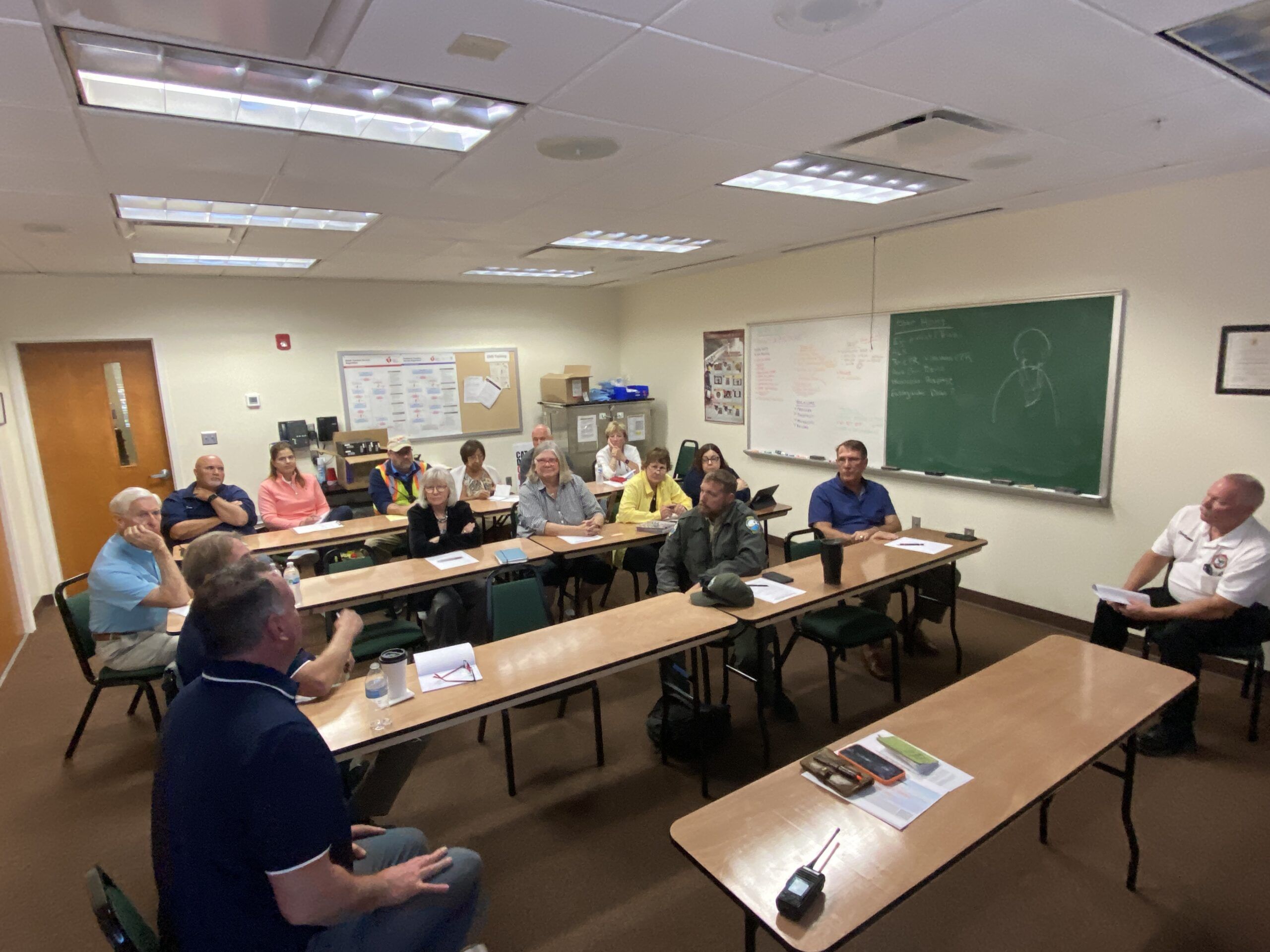Island emergency leads meet for Auxcomm introduction

The steering committee for Gasparilla Island’s new Auxiliary Emergency Communications system met Monday morning at the Boca Grande Fire Department to hear a presentation about the new system’s capabilities, and to discuss how the communications system will be used by groups and individuals.
The system, which consists of simple two-way radios and an island-wide antennae system, is designed to be a user-friendly backup in the event of the failure of local internet, power and telephone systems.
This was the situation during Hurricane Ian, when internet and cellphone service failed, in a situation that presenter Jon Blincoe, Director of Operations for vendor Suncoast Expeditionary Associates, called “when you are on your own.”
Blincoe and Suncoast’s Director of Engineering Jon Pellant presented an overview of the system’s capabilities with organization leaders from across the island, including representatives from the Gasparilla Island Bridge Authority, Florida State Parks, The Island School, Friends of Boca Grande, Boca Grande Club and the Gasparilla Island Conservation and Improvement Association, among others.
The Auxcomm group tested the system last month; it is already in use at the Gasparilla Island Bridge Authority and Boca Bay, where there are antennas. The working group is now ready to implement it across the island in advance of the beginning of the 2024 hurricane season. Training will begin in March.
The presentation was a refresher on how the system would work, and showed, according to Blincoe, “how this would fit into an island-wide emergency.”
The system is not a substitute for 911, or any current county system. Instead, it is a backup radio network that can be used on a daily basis by island organizations who need two-way radios, such as during a Friends event, or a large church fund-raiser.
The project has been a way for the Boca Grande Fire Department to work within the structure of the needs of the Lee County and Charlotte County emergency systems, yet respond to individual needs on the island, mostly during disasters, but at other times as well.
“You are split between two 911 districts and two counties,” Blincoe said.
Gasparilla Island is limited through its land lines, which were pulled out of the ground when the tower tipped on top of the Inn Bakery during Ian.
“You don’t get many fibers way out here,” Blincoe said.
Hand-held radios on the General Mobile Radio Service band are at the center of the service. The BTech GMRS Pro, available for about $150 on Amazon, is a two-way radio that requires only a simple Federal Communications Commission license, but it otherwise operates much like a traditional walkie talking. For Auxcomm, there are two types of sets, one given out to institutions for daily use, and a second higher tier of service of Motorola phones, the MOTOTRBO, a $1,600 set designed only for emergencies. Services are on separate bands, so that there is plenty of space for different needs.
Later, there will be other additions to the project, including drones, for use in surveying the island after a hurricane.
“They used to be kids’ toys,” Blincoe said. “Not so much anymore.”
In the event of a disaster, the Fire Department would be an information hub, with a room with video monitors, rosters of personnel and even grease pencil boards. The group is also planning on an intranet, to make sure that if the internet goes down, the information needed is still available. The antennae for the system are secure locations at Boca Bay, the Bridge and Fire Department.
“We chose places that fared well after Ian,” said Chief C.W. Blosser of the Boca Grande Fire Department, who is in charge of the program.
Now that the system is in place, there will be training on the radios, and further disaster training.
The system would also include a series of trained volunteers, who might, for instance, go on health and welfare checks, according to Pellant.
One key part of the future work of the group is CERT training, which stands for Community Emergency Response Team. CERT training, developed by the Department of Homeland Security, involves disaster response, first aid, terrorism awareness and basic search and rescue. It is designed for average citizens, not professionals, to get them trained in basics like CPR. Charlotte County has one of the largest CERT teams in the nation. In Rotonda West, for instance, over 170 citizens were trained by Charlotte County.
In a question-and-answer period, attendees talked about needs. For instance, Friends of Boca Grande Chief Executive Marta Howell asked about the redundancy of internet, if Comcast went down again. Many used Starlink; this is a help on a daily basis, and not just a storm. However, during a storm the lowest tier of the service is slow.
So far, the system has raised an astonishing $376,000 in donations and pledges. While there will be future needs and maintenance, Blincoe is using the philosophy of. “minimum viable product.”
“The process drives what equipment we need,” Blincoe said.
The goal, according to Project Manager George B. “Bo” Hamrick, is to be “as ready as humanly possible by June 1.” Part of that process is to identify and get volunteers trained on the radios and with CERT training, so the island is ready.
“We want to identify people who want to volunteer,” Blosser said.
Training ahead
For organizations using the hand-held radios, there will be a two-hour training course from 10 a.m. to noon on March 19. Other classes will be on March 28, April 2, April 11, April 25 and April 30. The classes are limited to 20, so call Julie Brooks at the Fire Department at (941) 964-2908 or email admin@bocagrandefire.com









